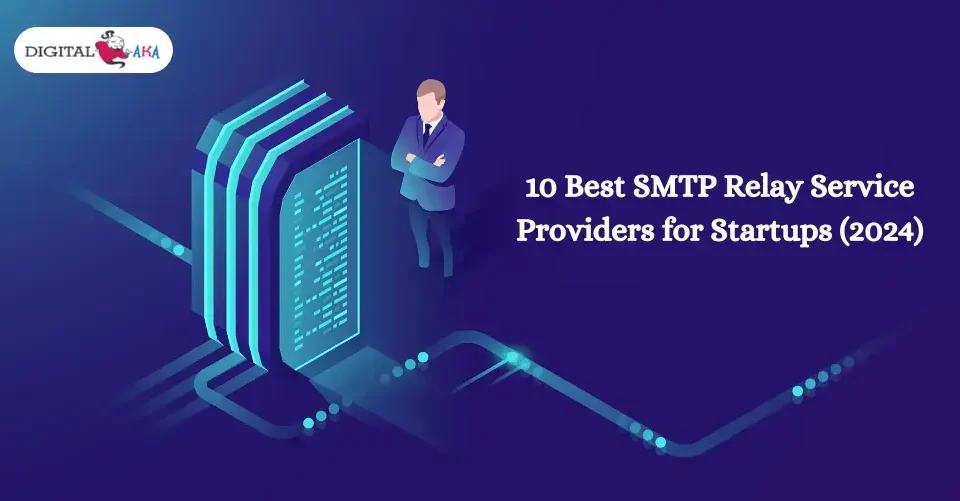
Best SMTP server for mass email marketing
May 29, 2023
Cold Email Service Provider- Ultimate Guide for Cold Email Marketing
June 16, 2023Setting up a Linux mail server is an important step for individuals and organizations who want to have full control over their email communication. By having your own SMTP Server For Email Marketing, you can ensure privacy, security, and seamless email delivery. In this article, we will explore the process of setting up and configuring a Linux mail server, covering everything from choosing the right Linux distribution to securing the server.
Table of Contents
Understanding and Configure Linux Mail Servers
A Linux mail server is a software application or a combination of applications running on a Linux-based operating system, designed to handle, send, receive, and store emails. This integral component of network infrastructure facilitates electronic communication within organizations and across the internet. Understanding the key elements and functionalities of Linux mail servers is important for administrators and users alike.
Components of Linux Mail Servers:
- Mail Transfer Agent (MTA): At the core of a Linux mail server is the Mail Transfer Agent. Popular MTAs like Postfix, Sendmail, and Exim handle the routing and delivery of emails. They communicate with other mail servers to transport messages across the internet.
- Mail Delivery Agent (MDA): The Mail Delivery Agent is responsible for delivering emails to the recipient’s mailbox. Procmail and Dovecot are common MDAs that work in tandem with MTAs to ensure successful delivery and storage of emails.
- Mail User Agent (MUA): The Mail User Agent is the interface through which users interact with the mail server. Common MUAs include desktop clients like Thunderbird or Evolution, and web-based interfaces such as Roundcube or SquirrelMail.
Protocols Used in Linux Mail Servers:
- Simple Mail Transfer Protocol (SMTP): SMTP is the protocol used for sending emails. It defines how messages are relayed between mail servers. Outgoing emails are transmitted using SMTP to the recipient’s mail server.
- Post Office Protocol (POP) and Internet Message Access Protocol (IMAP): POP and IMAP are protocols used by mail clients to retrieve emails from the server. POP is known for downloading emails to the client device, while IMAP allows users to access and manage emails directly on the server.
Key Functionalities:
- User Authentication: Linux mail servers implement secure authentication mechanisms to verify the identity of users. This ensures that only authorized individuals can send, receive, and access emails.
- Spam Filtering: To combat unsolicited emails, Linux mail servers often incorporate spam filtering mechanisms. These filters analyze incoming messages, identifying and segregating spam or potentially harmful content.
- SSL/TLS Encryption: Security is paramount in email communication. Mail server Linux supports SSL/TLS encryption protocols to secure the transmission of sensitive data, protecting emails from interception or tampering during transit.
- Mail Queues and Logs: Mail servers maintain queues to manage the orderly processing of emails. Detailed logs provide administrators with insights into the server’s activities, aiding in troubleshooting and monitoring.
Configuration and Administration:
- DNS Configuration: Proper Domain Name System (DNS) configuration is essential for Linux mail servers. DNS records like MX (Mail Exchange) records specify the best mail servers responsible for receiving emails for a domain.
- User Account Management: Administrators oversee user accounts, managing permissions and access. User authentication methods, including usernames and passwords, ensure secure access to email services.
- Server Security: Securing the Linux environment hosting the mail server is critical. Regular updates, firewalls, and intrusion detection systems contribute to a robust security posture.
There are several popular Mail Server Linux software options available, including Postfix, Exim, and Sendmail. These software packages provide the necessary functionality to handle email communication on a Linux system.
Choosing the Right Linux Distribution
Ubuntu stands out as an excellent option for mail server on a Linux administration beginners due to its winning combination of a user-friendly interface, straightforward installation process, and a robust community. This trifecta ensures a seamless onboarding experience and dependable support for those navigating the complexities of mail server setup.
CentOS: Stability and Reliability for Server Environments
Overview: CentOS is widely recognized for its stability and security features, positioning it as a preferred choice for server environments where reliability is paramount.
Long-Term Support: One of CentOS’s strengths lies in its long-term support (LTS) model. This means that users can rely on consistent updates and security patches over an extended period. For mail servers requiring a stable and predictable environment, CentOS stands out.
Security Features: CentOS is designed with security in mind, providing a robust foundation for server applications. This focus on security makes it well-suited for hosting a mail server Linux, where safeguarding sensitive communication is of utmost importance.
Suitability for Server Environments: Given its reputation for stability and security, CentOS is often the distribution of choice for server environments. It caters to users seeking a reliable platform for hosting critical services like mail servers.
Debian: Stability and a Diverse Package Ecosystem
Overview: Debian is celebrated for its emphasis on stability and reliability. It is an open-source distribution that forms the basis for various other Linux distributions, including Ubuntu.
Stability and Reliability: Debian’s commitment to stability makes it an attractive option for mail server deployments. The distribution prioritizes tested and proven packages, ensuring a dependable environment for hosting critical services.
Package Ecosystem: Debian boasts an extensive package ecosystem, providing users with a wide range of software options. This flexibility is advantageous for customizing a mail server setup based on specific requirements and preferences.
Community Engagement: Debian has a dedicated community of users and developers actively contributing to its development. This commitment to community engagement ensures continuous improvement and a responsive support system.
Considerations for Stability: If your priority is a stable and reliable platform with a diverse package ecosystem, Debian is a distribution worth considering for your mail server setup.
Installing the Linux Mail Server Software
Once you have chosen one of the best Linux distributions that best suits your needs, it’s time to install the mail server software. The exact process may vary depending on the distribution you have chosen.
Update the system: Before installing linux mail server software, it’s essential to update your Linux system to ensure you have the latest security patches and bug fixes.
Install the mail server software: Use the package manager of your Linux distribution to install the chosen linux mail server software. For example, if you are using Ubuntu, you can install Postfix by running the command: sudo apt-get install postfix.
Configure the mail server: During the installation process, you will be prompted to provide configuration details such as the domain name and relay settings. Follow the on-screen instructions and enter the appropriate information.
Configuring Linux Email Server
After the installation, you need to configure the SMTP Server For Bulk Email to ensure it functions correctly. Here are some essential configurations to consider:
Domain setup: To configure your mail server for your domain, establish MX (Mail Exchanger) records in your domain’s DNS settings. These records specify the mail server responsible for receiving emails on behalf of your domain, ensuring seamless communication and proper routing of incoming messages.
DNS records: Ensure seamless email delivery by configuring essential DNS records. Set up A (Address) records for accurate mail server identification, PTR (Pointer) records to establish reverse DNS lookup, and SPF (Sender Policy Framework) records to prevent outgoing emails from being flagged as spam. Proper DNS configuration is key to reliable email communication.
SMTP settings: Configure your Simple Mail Transfer Protocol (SMTP) settings meticulously to enhance email security. Implement robust authentication measures and encryption options to safeguard sensitive information during transmission. A well-configured SMTP setup ensures the integrity and confidentiality of your email communication, fortifying your digital correspondence against potential threats.
Mailbox configuration: Establish user accounts and mailboxes on your Linux email server, customizing access for seamless communication. Optimize email routing by configuring aliases and distribution lists. This efficient setup streamlines user interaction, ensuring smooth communication flows within your mail server environment.
Securing the Linux Mail Servers
Security is an important aspect of best Linux email server setup. Consider the following measures to secure your Linux mail server:
Regular Backups and Recovery Plans
Regular backups and recovery plans are essential components of a secure mail server strategy. Establish a strong backup regimen to routinely duplicate critical data on the server. Simultaneously, craft detailed recovery plans that outline swift and efficient procedures in case of a security breach. These measures not only mitigate potential data loss during incidents but also facilitate a timely restoration of services, ensuring minimal disruption and maintaining the integrity of vital information on the mail server.
Firewall configuration
Establish a robust firewall configuration to fortify your mail server’s security. Restrict access by permitting only essential connections, notably from trusted sources like your chosen SMTP Service Provider and IMAP/POP3 services. This proactive measure ensures that unauthorized access attempts are thwarted, safeguarding your Linux email server from potential threats and unauthorized intrusions.
Regular Security Audits and Assessments
Regular security audits and assessments are vital for maintaining the robustness of a system. By routinely scrutinizing the infrastructure, administrators can pinpoint potential vulnerabilities and weaknesses. Incorporating penetration testing, which emulates real-world cyber attacks, allows for a comprehensive evaluation of the system’s resilience. This proactive approach enables prompt identification and mitigation of security gaps, ensuring the continuous improvement of the security posture and minimizing the risk of exploitation by malicious entities.
SSL/TLS encryption
Implementing SSL/TLS encryption is paramount for bolstering the security of your mail server. By enabling this encryption protocol, you establish a secure and encrypted communication channel between the mail server and email clients. This ensures that sensitive information, including email content and login credentials, is protected from potential eavesdropping and unauthorized access, enhancing the overall confidentiality and integrity of email transmissions.
Robust Authentication Mechanisms
Employing robust authentication mechanisms is critical for securing Linux mail servers. This involves implementing strong authentication protocols, such as multi-factor authentication (MFA). MFA adds an additional layer of security by requiring users to provide multiple forms of identification, such as a password and a temporary code sent to their mobile device. By enforcing MFA, unauthorized access is significantly mitigated, enhancing the overall security posture of the mail server and safeguarding sensitive email communications from potential breaches.
Spam filtering
Utilize robust spam filtering mechanisms to proactively thwart the influx of unsolicited emails into users’ mailboxes. Deploy reputable tools like SpamAssassin or consider integration with third-party anti-spam solutions for enhanced protection. These measures not only minimize the risk of phishing attacks but also contribute to a more secure and streamlined email communication environment for your users.
Regular Software Updates and Patch Management
These are integral to maintaining a secure the best mail server linux. This involves keeping both the operating system and all software components current with the latest security patches. By consistently applying updates, administrators can address known vulnerabilities, fix software bugs, and enhance overall system security. This proactive approach minimizes the risk of exploitation by malicious actors and ensures that the server is fortified against evolving threats, contributing to a robust and resilient security posture.
Monitoring and Logging
Establishing monitoring and logging practices for Linux mail servers is crucial for proactive security. Employ real-time monitoring tools to track both user activities and system events in real-time. This constant surveillance allows administrators to swiftly detect anomalies and potential security incidents. By maintaining comprehensive logs for analysis, administrators gain valuable insights into the server’s behavior, facilitating quick identification of any irregularities and enabling timely response to potential security threats. This proactive approach is essential for maintaining the integrity and security of the mail server infrastructure.
Testing and Troubleshooting the Best Linux Mail Server
Setting up the best mail server Linux is an important step, but the true measure of its effectiveness lies in robust testing and troubleshooting. These essential steps not only validate the functionality of the server but also proactively address potential issues, ensuring a seamless email communication experience.
Sending and Receiving Test Emails
The first and foremost step in testing a newly configured mail server is to send and receive test emails. This involves initiating email communications from various accounts to verify the server’s ability to successfully deliver messages to the intended recipients. By sending test emails from different accounts, administrators can confirm that emails traverse the network securely and reach the correct mailboxes without any disruptions.
Monitoring Logs for Insights
Monitoring mail server logs is a critical aspect of testing and troubleshooting. Logs provide valuable insights into the server’s activities, capturing errors, warnings, and other relevant information. Administrators should vigilantly analyze these logs to identify any configuration or connectivity issues that may impact the server’s performance. By closely monitoring logs, administrators can promptly address emerging problems, ensuring the server operates at its optimal capacity.
Blacklist Checks: Safeguarding Email Deliverability
Email deliverability is a key concern for any mail server, and being blacklisted can have detrimental effects. As part of the testing and troubleshooting process, administrators should conduct regular checks to ensure that the mail server’s IP address is not listed on popular spam databases. Blacklisting can result from various factors, including suspicious activities or misconfigurations. Regular verification mitigates the risk of being blacklisted, safeguarding the server’s reputation and ensuring emails reach their intended recipients.
Comprehensive Diagnostics and Testing Tools
Utilizing advanced diagnostic and testing tools is instrumental in identifying potential vulnerabilities and ensuring the mail server’s resilience. These tools can assess various aspects of the server, including its response to common security threats, adherence to industry standards, and overall performance. By leveraging such tools, administrators can conduct thorough tests, uncover potential weaknesses, and implement preemptive measures to fortify the server’s security.
Load Testing for Scalability
Scalability is a crucial aspect of a mail server’s functionality, especially in environments with varying levels of email traffic. Load testing allows administrators to simulate high-volume scenarios, assessing how well the server handles increased email loads. By subjecting the server to controlled stress, administrators can identify performance thresholds, optimize configurations, and ensure that the best linux mail server remains responsive even during peak usage periods.
Continuous Improvement through Feedback Loops
The testing and troubleshooting process should not be viewed as a one-time task but rather as an ongoing commitment to continuous improvement. Establishing feedback loops that encourage users to report any issues or anomalies they encounter enhances the administration’s ability to address concerns promptly. Regular user feedback, coupled with proactive testing, ensures that the mail server evolves to meet the dynamic demands of email communication.
Conclusion
Setting up and configuring Linux mail servers provides numerous benefits, including privacy, control, and efficient email communication. By following the outlined steps, you can successfully establish your own Linux mail server solution.
Throughout this article, we have discussed the importance of understanding Linux mail servers and choosing the right distribution for your needs. SMTP Service Provider explored the installation process of the mail server software and the crucial configurations required for proper functionality. Additionally, we emphasized the significance of securing the mail server to protect it from unauthorized access and spam.
Remember to regularly update and maintain your mail server to ensure it remains secure and efficient. Monitor logs, test email functionality, and promptly address any issues that arise. Setting up and configuring the best linux mail server may seem complex at first, but with the right approach and understanding, you can achieve a reliable and secure email communication platform.




